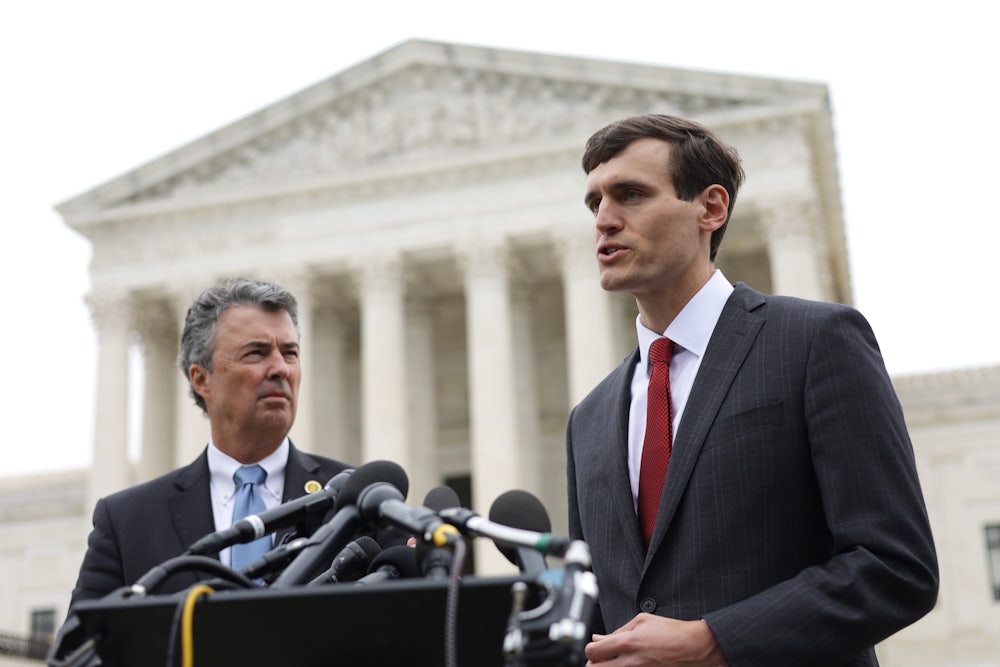A federal court in Alabama threw out the state’s latest map for congressional districts on Tuesday, ruling that the state legislature had violated the Voting Rights Act of 1965, or VRA, by refusing to draw a second majority-Black district. The special three-judge court said it would now appoint a special master to draw a neutral map to replace the current one.
“Wait a second,” you might be asking yourself, “didn’t I already read about this? I thought the Supreme Court already ruled against Alabama’s congressional districts earlier this summer.” And you would be correct! The Supreme Court did indeed strike down those districts in June. But the state of Alabama has apparently chosen to defy the federal courts rather than let a second majority-Black congressional district be drawn.
“We are disturbed by the evidence that the State delayed remedial proceedings but ultimately did not even nurture the ambition to provide the required remedy,” the three-judge panel wrote in its order on Tuesday. “And we are struck by the extraordinary circumstance we face. We are not aware of any other case in which a state legislature—faced with a federal court order declaring that its electoral plan unlawfully dilutes minority votes and requiring a plan that provides an additional opportunity district—responded with a plan that the state concedes does not provide that district.”
Alabama is not defying the federal courts just for fun. The state lost in June because a majority of the justices—Chief Justice John Roberts, Justice Brett Kavanaugh, and the court’s three liberals—found its interpretation of the court’s VRA precedents to be deeply unpersuasive. So Alabama now wants a second bite of the apple—not just to avoid drawing a second majority-Black congressional district but also to ensure that the federal courts cannot use the VRA to remedy racial-gerrymandering problems ever again.
The case, Allen v. Milligan, began in 2021 when voting rights groups filed a federal lawsuit to challenge Alabama’s congressional districts, which had been redrawn after the 2020 census to take population changes into account. Voting rights groups argued that the state had intentionally diluted the votes of Black Alabamians by not drawing a second majority-Black congressional district in the southern portion of the state. A special three-judge panel in the federal district court ruled in favor of the voting rights groups, concluding that the case was “not close.”
Voting rights groups do not typically fare well before the Roberts court. So it was a surprise in June when the Supreme Court issued a 5–4 decision to uphold the district court’s ruling. The decision, authored by Roberts himself, was hardly a ringing endorsement of the panel’s reasoning and judgment. It was nonetheless classic Roberts: He tenuously reaffirmed the courts’ remedial powers under Section 2 of the Voting Rights Act in large part because Alabama’s arguments were unworkable and unconvincing.
“The concern that Section 2 may impermissibly elevate race in the allocation of political power within the States is, of course, not new,” Roberts wrote, referring to traditional conservative criticism of the VRA. “Our opinion today does not diminish or disregard these concerns. It simply holds that a faithful application of our precedents and a fair reading of the record before us do not bear them out here.”
As I noted earlier this summer, Alabama lawmakers nonetheless refused to comply. They instead drew a newish map where eligible Black voters only made up 39.93 percent of the state’s second congressional district. While a majority-minority district does not need to be exactly above 50 percent to meet VRA scrutiny, it must at least be close. Alabama officials did not hide their disdain for the federal courts when approving the new map.
“Following the U.S. Supreme Court order, I called the Alabama Legislature into a special session to readdress our congressional map,” Governor Kay Ivey said after signing the new maps into law in July. “The Legislature knows our state, our people, and our districts better than the federal courts or activist groups, and I am pleased that they have answered the call, remained focused, and produced new districts ahead of the court deadline.”
That placed the ball back in the three-judge panel’s court, where the state raised a new argument. In a court filing last month, Alabama argued that the Supreme Court’s ruling in Students for Fair Admissions v. Harvard, which was handed down after the justices decided the gerrymandering case, set new legal thresholds for when it is permissible for the government to undertake “race-based government action.” In this context, that would include the VRA’s ability to require states to draw majority-minority districts in redistricting cases that involve racial gerrymandering. “Redistricting is not an exception to the rule,” the state argued.
“Allen, in addressing whether … there was a VRA violation in the 2021 Plan, did not decide any Equal Protection Clause claims regarding the constitutionality of any proposed remedy that will now govern every voter in the State of Alabama,” the state argued. “Any such remedy must be consistent with the Supreme Court’s Equal Protection Clause cases, including most recently Harvard.”
The state now wants Section 2 remedies to be weighed under what is known as strict scrutiny, the most stringent test that the federal courts can apply to a government action. Such actions can only prevail if they, among other factors, address a “compelling government interest.” Alabama noted that the Supreme Court “has assumed without deciding that compliance with Section 2 is a compelling interest,” but added that such assumptions do not amount to binding legal conclusions.
“Maps like the ones [voting rights groups] propose would also create majority-minority districts ‘in greater numbers than they otherwise would have been’ if race hadn’t been used,” the state argued, quoting from the Harvard ruling. “But the Constitution forbids using race ‘to discriminate against those racial groups that were not the beneficiaries of the race-based preference.’” In other words, the courts’ cure for unconstitutional racial gerrymandering would itself amount to unconstitutional racial gerrymandering in Alabama’s eyes.
In Tuesday’s ruling, the panel strenuously rejected the idea that drawing a second majority-Black district would itself violate the Constitution. “The Voting Rights Act does not provide a leg up for Black voters—it merely prevents them from being kept down with regard to what is arguably the most ‘fundamental political right,’ in that it is ‘preservative of all rights’—the right to vote,” it said, quoting from other voting rights rulings. Adopting Alabama’s reasoning, the panel concluded, “would fly in the face of forty years of Supreme Court precedent—including precedent in this case.” (Emphasis theirs.)
The panel also expressed concern with Alabama’s overall approach to this case. “We have reached these conclusions only after conducting an exhaustive analysis of an extensive record under well-developed legal standards, as Supreme Court precedent instructs,” the panel wrote. “We do not take lightly federal intrusion into a process ordinarily reserved for the State Legislature. But we have now said twice that this Voting Rights Act case is not close. And we are deeply troubled that the State enacted a map that the State readily admits does not provide the remedy we said federal law requires.”
Under federal voting rights law, rulings in redistricting cases like this one can be appealed directly to the Supreme Court. There, the state of Alabama apparently hopes that Kavanaugh will be more favorable to it this time around. In a concurring opinion to the court’s June ruling, Kavanaugh favorably cited Justice Clarence Thomas’s dissenting argument that redrawing the state’s congressional districts might violate Section 2. “But Alabama did not raise that temporal argument in this Court, and I therefore would not consider it at this time,” he wrote. Thanks to Alabama’s aversion to obeying the federal courts, that time may be upon us.










